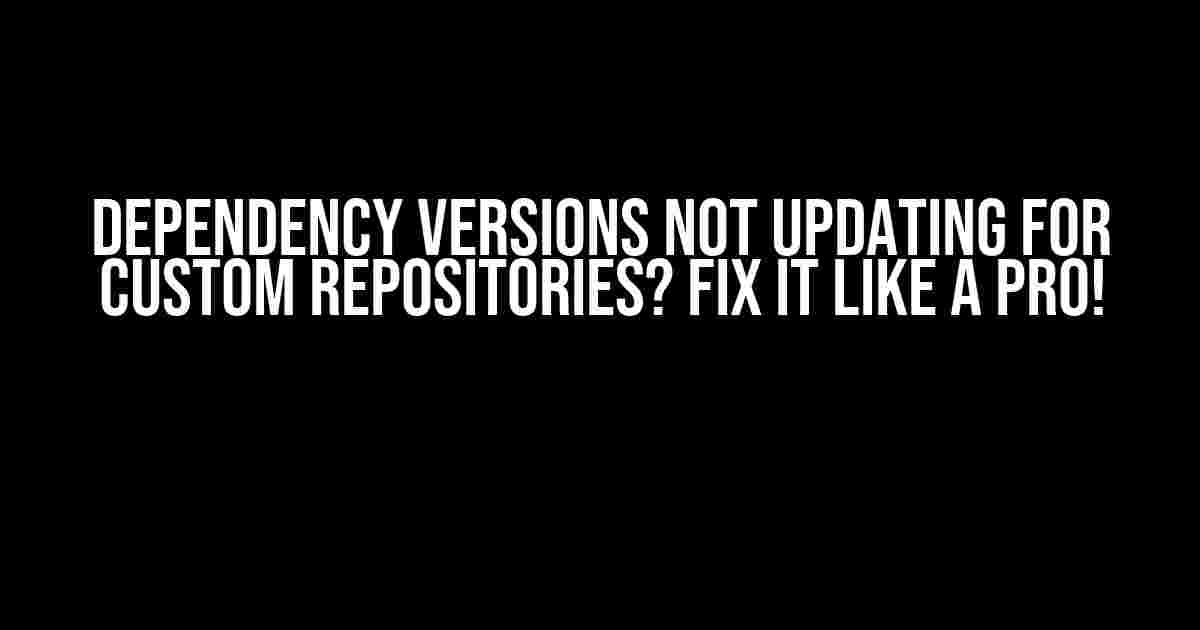Are you tired of dealing with outdated dependency versions in your custom repositories? Do you find yourself wondering why your dependency versions aren’t updating automatically? Well, wonder no more! In this article, we’ll dive deep into the world of custom repositories and explore the common issues that prevent dependency versions from updating. Buckle up, folks, and get ready to learn how to fix this pesky problem once and for all!
What Are Custom Repositories, Anyway?
Custom repositories can be incredibly useful for large-scale projects or projects with complex dependency trees. By centralizing your dependencies, you can easily track and manage changes, ensuring that your project stays up-to-date and runs smoothly.
Why Aren’t My Dependency Versions Updating?
- Incorrect Repository Configuration: Perhaps your repository configuration is incorrect, preventing dependencies from updating properly. Double-check your configuration files to ensure that everything is set up correctly.
- Dependency Conflicts: Dependency conflicts can prevent updates from happening. Check your dependency tree for any conflicts that might be blocking updates.
- Cache Issues: Cache issues can also prevent dependency versions from updating. Try clearing your cache and retrying the update process.
- Network Connectivity Issues: Network connectivity issues can prevent your repository from communicating with the dependency servers. Check your network connection and ensure that it’s stable and fast.
- Permission Issues: Permission issues can prevent updates from happening. Ensure that your repository has the necessary permissions to update dependencies.
Solving the Problem: A Step-by-Step Guide
- Check Your Repository Configuration:
// Check your repository configuration file // Ensure that the configuration is correct and up-to-date // Update the configuration file if necessary - Clear Your Cache:
// Clear your cache using the appropriate command // For example, if you're using npm, run the following command npm cache clean --force - Update Your Dependencies:
// Update your dependencies using the appropriate command // For example, if you're using npm, run the following command npm update - Check for Dependency Conflicts:
// Check your dependency tree for conflicts // Use a tool like npm-audit or yarn-audit to identify conflicts // Resolve conflicts by updating or removing dependencies as necessary - Verify Network Connectivity:
// Check your network connection to ensure it's stable and fast // Try updating your dependencies again once your network connection is stable - Check Permissions:
// Ensure that your repository has the necessary permissions to update dependencies // Check your repository's permissions and adjust as necessary
Best Practices for Managing Custom Repositories
- Regularly Update Your Dependencies: Regularly update your dependencies to ensure that you have the latest versions.
- Use a Consistent Dependency Management Tool: Use a consistent dependency management tool, such as npm or yarn, to manage your dependencies.
- Monitor Dependency Conflicts: Regularly monitor your dependency tree for conflicts and resolve them as soon as possible.
- Optimize Your Repository Configuration: Optimize your repository configuration to ensure that it’s efficient and up-to-date.
- Implement Automated Dependency Updates: Implement automated dependency updates to ensure that your dependencies are always up-to-date.
Conclusion
By following the instructions outlined in this article, you’ll be well on your way to becoming a master of custom repository management. So go ahead, take control of your dependencies, and watch your project thrive!
| Common Issues | Solutions |
|---|---|
| Incorrect Repository Configuration | Check and update repository configuration |
| Dependency Conflicts | Check and resolve dependency conflicts |
| Cache Issues | Clear cache and retry update |
| Network Connectivity Issues | Check and ensure stable network connection |
| Permission Issues | Check and adjust repository permissions |
Need more help? Check out our extensive guide on custom repository management for more tips and tricks.
Frequently Asked Question
Stuck with outdated dependencies in your custom repositories? We’ve got you covered!
Why are dependency versions not updating for my custom repositories?
This might happen if your custom repository’s dependency version is hardcoded or not configured to update automatically. Double-check your repository settings and ensure that the version is set to the latest or a version range that allows updates.
How do I configure my custom repository to update dependencies automatically?
To enable automatic updates, you can set the dependency version to a range, such as “1.2.x” or “^1.2.3”, which allows the package manager to install the latest version within that range. Alternatively, you can use a package manager like npm or yarn to manage your dependencies and update them with a single command.
What if I want to use a specific version of a dependency in my custom repository?
No problem! You can specify a fixed version of a dependency by setting the version to a specific number, such as “1.2.4”. This will ensure that your custom repository always uses that exact version. Just keep in mind that you’ll need to manually update the version when a new one is released.
Can I use a mix of fixed and dynamic versions for my dependencies?
Yes, you can! You can set some dependencies to fixed versions and others to dynamic versions that update automatically. Just be aware of potential conflicts or issues that might arise from mixing these approaches. It’s essential to carefully manage your dependencies to avoid any potential problems.
How often should I update my custom repository’s dependencies?
It’s a good practice to regularly review and update your dependencies to ensure you have the latest security patches and features. The frequency of updates depends on your project’s needs and the rate of changes in your dependencies. You can set up automatic updates or schedule regular manual updates to keep your dependencies fresh and secure.
